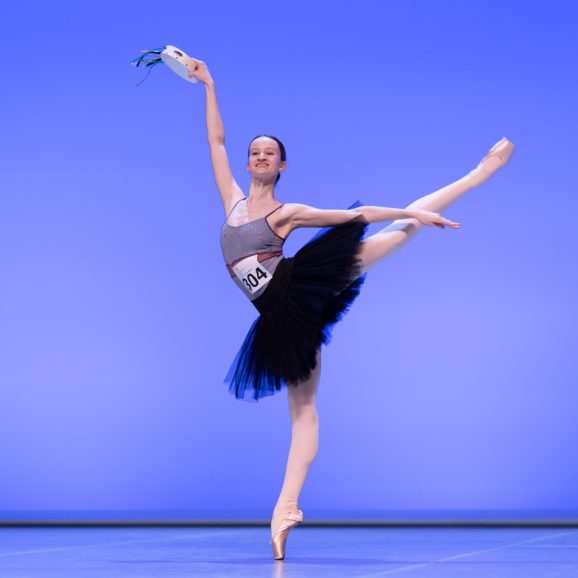 The Prix de Lausanne distinguishes itself from other competitions thanks to a holistic and ethical approach. Since 2000, a health check has been introduced in the registration procedure, in collaboration with a specialised consultant physician. The Prix de Lausanne firmly advocates the principle that in order to be a good dancer, one must be in good physical and mental health. Although the aesthetic canons of classical ballet demand that both male and female dancers be slender, it is vital that the importance given to this criterion should not jeopardise their state of health and have a detrimental influence on their future career.
The Prix de Lausanne distinguishes itself from other competitions thanks to a holistic and ethical approach. Since 2000, a health check has been introduced in the registration procedure, in collaboration with a specialised consultant physician. The Prix de Lausanne firmly advocates the principle that in order to be a good dancer, one must be in good physical and mental health. Although the aesthetic canons of classical ballet demand that both male and female dancers be slender, it is vital that the importance given to this criterion should not jeopardise their state of health and have a detrimental influence on their future career.
The Prix de Lausanne Health Policy: Why? And how?
Reaching peak performance in classical ballet calls for exceptional physical, mental, technical and artistic skills. At the same time, and despite the high levels of physical exertion involved, ballet’s aesthetic criteria encourage dancers to be lean. To achieve what they believe to be the required degree of leanness, dancers very often control their weight by rigorously limiting their energy intake. This kind of chronic restriction of calories, to maintain excessive thinness, is extremely harmful to a dancer’s health in both the short and long term. There is considerable evidence that excessive thinness and malnutrition affects physical growth, pubertal development, morbidity, mortality, cognitive development, reproduction, physical performance and bone health as well as increasing the risk of several adult-onset chronic diseases. Compromising health in pursuit of thinness will not only reduce the dancer’s ability to sustain the rigours of a professional career, it can also have severe and extreme consequences. Some of the risks include: Cardiac arrhythmia and risk of heart attack, kidney failure reduced bone health and risk of stress fractures and osteoporosis, reduced or impaired fertility, suppressed immune system, leading to risk of infection, hair thinning and loss, skin problems.
Dr Carlo Bagutti
Directeur médical du Centre de Médecine du Sport, Groupe Vidy-Med
Want to know more? Read the full article!
Interview with Dr. Carlo Bagutti and the Prix de Lausanne Organizing Committee
Is it possible these days to achieve quality performance without taking physical risks?
Reaching peak quality performance in the field of classical dance calls for extremely high physical, technical and artistic attributes. The risk of injury within this quest is relatively low. However, certain dancers might seek to emulate – or be encouraged to emulate – the achievements of dancers with extreme physical capabilities such as exceptional flexibility or flat turn out. Through forcing their bodies to mimic another dancer’s skills, rather than gradually enhancing their own, these dancers run the risk of serious ‘overload’ injuries, with long term consequences to their dancing careers.In recent years, the Prix de Lausanne has also devoted attention to the issue of excessive thinness, or even anorexia, in young female dancers. Is anorexia a significant or a marginal phenomenon?
Anorexia is far more prevalent in the general population than one might imagine. In certain fields (such as classical ballet, fashion modelling, and sports such as artistic gymnastics, ice-skating and running) where the aesthetic appearance and weight are particularly in the spotlight, it is even more widespread. Nonetheless, the majority of problems stem from eating disorders related to but less serious than fully-fledged anorexia. These anorexic-types of behaviours, which occur more frequently than fully-fledged anorexia, also jeopardize the health of such individuals, particularly if they are young people in the midst of their growth period. There is a growing awareness that the psychological demands of training to be a professional dancer need to be acknowledged and understood. Is it psychologically more difficult to perform ballet than to engage in another artistic or sports discipline? Ballet requires considerable personal investment. From childhood on it is the focal point of the young dancer’s life. In itself, experiencing dance through one’s body generates tremendous personal passion in both physical and psychological terms. As dancers need to devote so much time and energy to their training, they generally forego the usual balance of leisure and social activities. Therefore, it is extremely beneficial if family support and friendships can be adapted so that the dancer is not always forced to choose between their training and friendships and family activities.Despite the short period of time in which you, as the Prix’s consulting physician, are in contact with the participants, what steps can you take to raise young people’s awareness of the benefits of healthy training practices and nutritional choices?
Our health-oriented educational project has a three-pronged thrust. First of all, the candidate receives a medical document that must be completed in the presence of a family doctor. This is accompanied by a detailed questionnaire regarding nutritional behavioural disorders. The aim of this medical file is to raise awareness of potential problems related to disordered eating among candidates, and those around them, and to provide the family doctor with an opportunity to discuss these issues. This information from the family physician, shared with me in strict confidence, allows me to form an opinion of the dancer’s state of health and identify dancers at risk. My personal interventions during the competition represent the second focus of our action. Thirdly, In situations that I consider particularly risky, I draw up a strategy for subsequent care and monitoring of the young dancer’s health. Doesn’t responsibility for the health of these young dancers mostly lie with their parents and those supervising their training? That is absolutely true, but the organizing committee of the Prix de Lausanne feels that it is highly irresponsible to simply turn a blind eye to the health risks related to excessive thinness or to an injury due to excessive strain, as this compromises a dancer’s long-term development.



